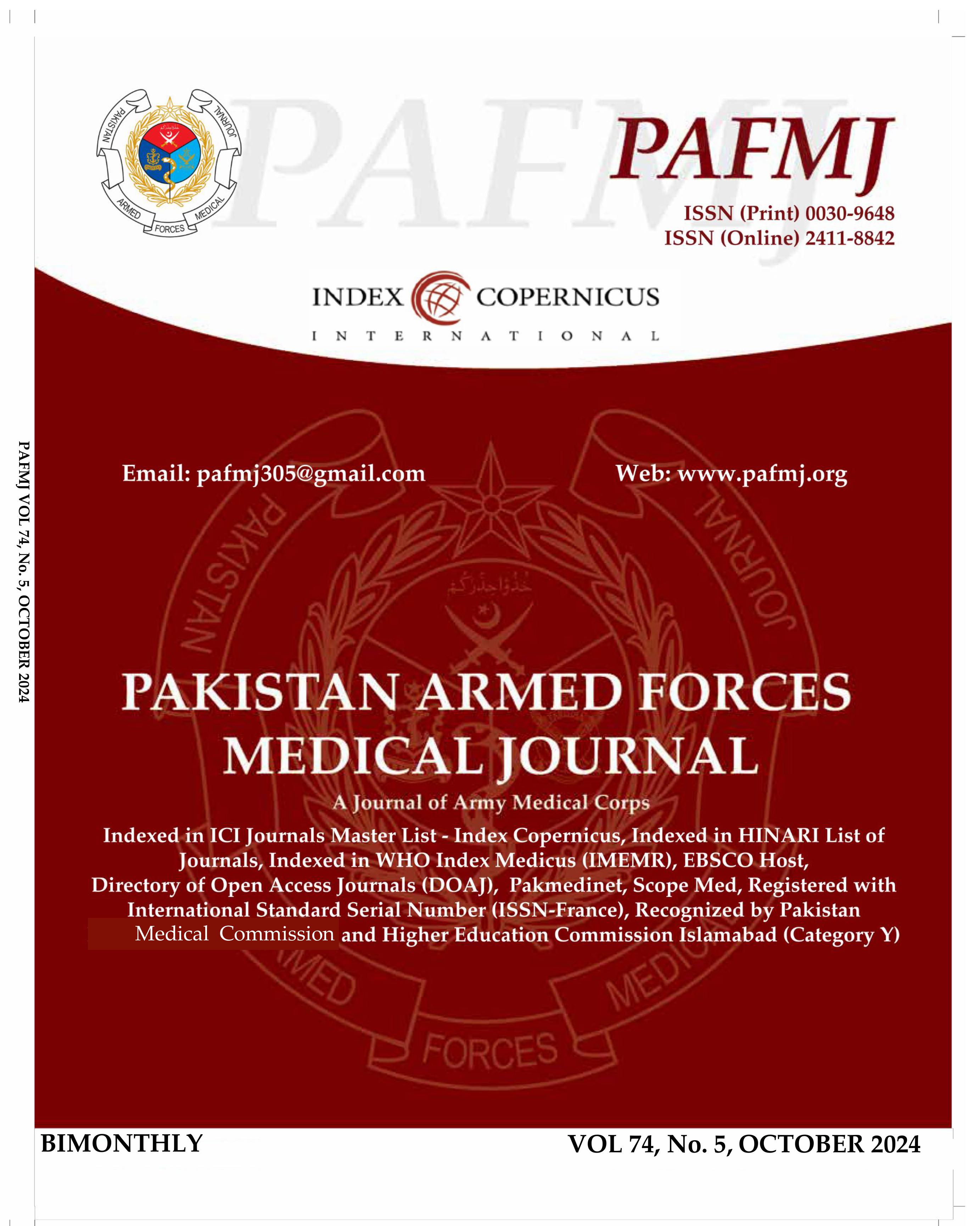Relationship of Dyspeptic Symptoms with Dinner to Breakfast Time Interval
DOI:
https://doi.org/10.51253/pafmj.v74i5.9021Keywords:
Dyspepsia, Gastroesophageal Reflux Disease, IndigestionAbstract
Objective: To ascertain the relationship of dyspeptic symptoms with dinner to breakfast time interval.
Study Design: Cross-sectional study.
Place and Duration of Study: Department of Gastroenterology, Liaquat National Hospital, Karachi Pakistan, from Aug 2021 to Apr 2022.
Methodology: We enrolled patients of either gender, between 18 to 50 years of age, with persistent symptoms of dyspepsia for at least two months and/or confirmed cases of dyspepsia. Written, informed consent was taken from all patients prior to recruiting them. Patients visiting outpatient department with symptoms of dyspepsia and/or confirmed cases of dyspepsia were interviewed to fill out Short-form Leeds Dyspepsia Questionnaire (SF-LDQ).
Results: Total 400 patients were studied with nearly half of the participants being female 188 (47%) with 72(18%), 87(21.8%), 113(28.2%) and 128(32%) patients had dinner to breakfast duration of ≤8 hours, 8.1-10 hours, 10.1-12 hours and >12 hours, respectively. There was moderate positive correlation between fasting duration and SF-LDQ (r=0.46, p<0.001). Nightly fasting duration of more than 10 hours had increased risk of indigestion, heartburn and regurgitation.
Conclusion: Longer duration between dinner and breakfast was found to be associated with increased likelihood of dyspeptic symptoms including indigestion, heartburn and regurgitation.
Downloads
References
Paoli A, Tinsley G, Bianco A, Moro T. The influence of meal frequency and timing on health in humans: the role of fasting. Nutrients 2019; 11(4): 719. https://doi.org/10.3390/nu11040719
Sievert K, Hussain SM, Page MJ, Wang Y, Hughes HJ, Malek M, et al. Effect of breakfast on weight and energy intake: systematic review and meta-analysis of randomised controlled trials. BMJ 2019; 364: l42. https://doi.org/10.1136/bmj.l42
Coulthard JD, Palla L, Pot GK. Breakfast consumption and nutrient intakes in 4-18-year-olds: UK National Diet and Nutrition Survey Rolling Programme (2008-2012). Br J Nutr 2017; 118(4): 280-290.
https://doi.org/10.1017/S0007114517002214
Lopez-Minguez J, Gómez-Abellán P, Garaulet M. Timing of breakfast, lunch, and dinner. Effects on obesity and metabolic risk. Nutrients 2019; 11(11): 2624.
https://doi.org/10.3390/nu11112624
Baron JH, Watson F, Sonnenberg A. Three centuries of stomach symptoms in Scotland. Aliment Pharmacol Ther 2006; 24(5): 821-829. https://doi.org/10.1111/j.1365-2036.2006.03044.x
Jaber N, Oudah M, Kowatli A, Jibril J, Baig I, Mathew E, et al. Dietary and lifestyle factors associated with dyspepsia among pre-clinical medical students in Ajman, United Arab Emirates. Cent Asian J Glob Health 2016; 5(1): 192.
https://doi.org/10.5195/cajgh.2016.192
Clevers E, Törnblom H, Simrén M, Tack J, Van Oudenhove L. Relations between food intake, psychological distress, and gastrointestinal symptoms: a diary study. United European Gastroenterol J 2019; 7(7): 965-973.
https://doi.org/10.1177/2050640619863431
Yazdanpanah K, Moghimi N, Yousefinejad V, Ghaderi E, Azizi A, Nazem SF. Dyspepsia prevalence in general population aged over 20 in the west part of Iran. J Pak Med Assoc 2012; 62(7): 672-676.
Grainger SL, Klass HJ, Rake MO, Williams JG. Prevalence of dyspepsia: the epidemiology of overlapping symptoms. Postgrad Med J 1994; 70(821):154-161.
https://doi.org/10.1136/pgmj.70.821.154
McColl E. Best practice in symptom assessment: a review. Gut 2004;53 Suppl 4(Suppl 4):iv49-54.
https://doi.org/10.1136/gut.2004.053249
Potter C, Griggs RL, Brunstrom JM, Rogers PJ. Breaking the fast: meal patterns and beliefs about healthy eating style are associated with adherence to intermittent fasting diets. Appetite 2019; 133: 32-39.
https://doi.org/10.1016/j.appet.2018.10.035
Mehta M. Ideal time gap between meals: stomach as a batch reactor. 2014.
Lam YY, Ravussin E. Analysis of energy metabolism in humans: a review of methodologies. Mol Metab 2016; 5(11): 1057-1071. https://doi.org/10.1016/j.molmet.2016.09.005
Fändriks L. Roles of the gut in the metabolic syndrome: an overview. J Intern Med 2017; 281(4): 319-336.
https://doi.org/10.1111/joim.12586
Holst JJ, Gribble F, Horowitz M, Rayner CK. Roles of the gut in glucose homeostasis. Diabetes Care 2016; 39(6): 884-892.
https://doi.org/10.2337/dc16-0351
Xu JH, Lai Y, Zhuang LP, Huang CZ, Li CQ, Chen QK, et al. Certain dietary habits contribute to the functional dyspepsia in South China rural area. Med Sci Monit 2017; 23: 3942-3951.
https://doi.org/10.12659/msm.902784
Li Y, Su Z, Li P, Li Y, Johnson N, Zhang Q, et al. Association of symptoms with eating habits and food preferences in chronic gastritis patients: a cross-sectional study. Evid Based Complement Alternat Med 2020; 2020: 5197201.
https://doi.org/10.1155/2020/5197201
Wang C, Guo X, An Y, Xu S, Zhang D, Qin Y, et al. Risk factors of peptic ulcer in military personnel: a systematic review of the literature. Explor Res Hypothesis Med. 2020; 5(3): 103-109.
https://doi.org/10.14218/erhm.2020.00020
Jain U, Chauhan A, Gupta J, Gupta A. Evaluation of Boey scoring in predicting morbidity and mortality in peptic ulcer perforation peritonitis. Int J Surg 2021; 5(3): 41-43.
Verma A, Ranganna KM, Reddy RS, Verma M, Gordon NF. Effect of rosuvastatin on C-reactive protein and renal function in patients with chronic kidney disease. Am J Cardiol 2005; 96(9): 1290-1292. https://doi.org/10.1016/j.amjcard.2005.06.063
Downloads
Published
Issue
Section
License
Copyright (c) 2024 Vishal Kumar Chandkai, Shahid Karim, Adeel Rahat, Dheeraj Kumar, Punhal Khan, Madhuri Kumari

This work is licensed under a Creative Commons Attribution-NonCommercial 4.0 International License.















